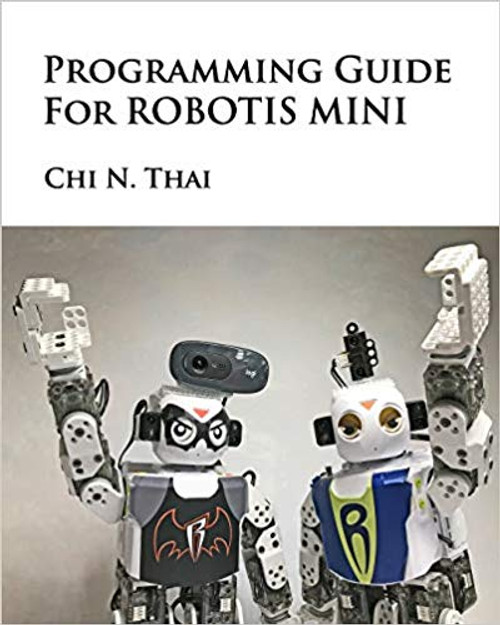Product Description
Learning Robotics with ROBOTIS PLAY Systems (Paperback)
Learning Robotics with ROBOTIS PLAY Systems Excerpts
This book contains 5 chapters:
1) Chapter 1 presents foundational concepts regarding the system design approach used by ROBOTIS in creating its educational kits and the Sense-Think-Act paradigm used in developing the contents of this book.
2) Chapter 2 describes the hardware characteristics of the PLAY700 kit and how to use the ROBOTIS MANAGER software tool using a “Basic Bot” design.
?
3) Chapter 3 is a substantial chapter providing a gradual but in-depth tutorial about applications of the R+TASK and R+PLAY700 software tools using two robot designs - “Spinning Top” and “Car Bot”. Topics included autonomous-behavior and remote-control algorithms, communication and multimedia programming techniques. PC and Mobile uses of the TASK tool will be shown.
?
4) Chapter 4 is also another substantial chapter mirroring the instructional approach and topics developed in Chapter 3 but now using the R+SCRATCH/SCRATCH 2 tool chain and its event programming features.
?
5) Chapter 5 presents selected mechanical design concepts inherent in the mechanical components provided in the PLAY700 kit, with the goal of helping students understand the mechanical design concepts represented in the original example robots from various PLAY systems, and be creative in their own robot designs by showcasing modified or additional mechanical concepts and robot designs.
?
Chapters 2 through 5 also provide appropriate source codes and tutorial videos to illustrate the presented concepts, along with review questions to help students master learned materials.
?
You can access the YouTube playlist of all 67 video tutorials here.
Book's Table of Contents
Chapter 1: Introduction
1.1 ROBOTIS System Design Approach
1.2 Sense-Think-Act Paradigm
1.3 References
1.4 Review Questions for Chapter 1
Chapter 2 - Getting Started
2.1 Using PLAY700 kit on Mobile Devices
2.2 Using PLAY700 kit on Windows PC
2.3 Building “Spinning Top” robot
2.4 Downloading Example Codes
2.5 Review Questions for Chapter 2
Chapter 3 - Using R+TASK & R+PLAY700
3.1 Learning Sequence Control in TASK programs
3.2 Learning Program Modularization with Functions in TASK programs
3.3 “Spinning Top” Maneuvers using IR Center Sensor
3.3.1 Solution using CM-50’s built-in speaker
3.3.2 Solution using Smartphone services: Text-Display, Text-to-Speech and Music-Play
3.4 “Avoider” Maneuvers using Left and Right IR Sensors
3.5 “Follower” Maneuvers using Left and Right IR Sensors
3.6 Remote Control Programming Techniques
3.6.1 Structure of a “Remocon” packet
3.6.2 Remote Control of “Spinning Top” robot using Virtual RC-100
3.6.3 Remote Control of “Spinning Top” robot using Touch Areas on Mobile Devices
3.6.4 Voice Control of “Spinning Top” robot using R+m.PLAY700 App
3.6.5 Remote Control using Gradient Tool (Tilt Sensor) on Mobile Device
3.7 Autonomous Line Tracking & Obstacle Avoidance with NIR Sensors
3.8 Using Mobile Video Camera for Color Line Tracking
3.9 Multimedia Moody Dog with R+m.PLAY700
3.10 Using Musical Instruments on CM-50 and Mobile Device
3.11 More Applications with Mobile Camera: Face and Intruder Detections
3.12 References
3.13 Review Questions for Chapter 3
Chapter 4: Using R+SCRATCH & SCRATCH® 2
4.1 Basic Robot Programming with SCRATCH
4.2 Sequential Control of Robot Maneuvers
4.3 “Spinning Top” Maneuvers using on Center IR Sensor
4.4 “Avoider” Maneuvers using Left and Right IR Sensors
4.5 “Follower” Maneuvers using Left and Right IR Sensors
4.6 Remote Control of CarBot via PC’s keyboard
4.7 Line Follower – Obstacle Avoider Project
4.8 Moody Dog Multimedia Project with SCRATCH
4.9 References
4.10 Review Questions for Chapter 4
Chapter 5: Selected Mechanical Design Concepts
5.1 Wheel Based Applications
5.1.1 Passive Front Supports/Wheels
5.1.2 Four-Wheel Drives
5.2 Linkage Based Applications
5.2.1 Four-Legged DogBot
5.2.2 Scorpion
5.2.3 Two-Arms Robot
5.2.4 Monkey’s Crawling Motion
5.2.5 Seal’s Hitching Motion
5.2.8 Goldfish’s Tail Wagging Motion
5.2.9 Caterpillar’s Crawling Motion
ISBN-10: 0999391801
ISBN-13: 978-0999391808















